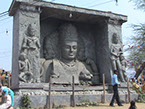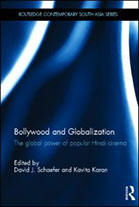 Reviews
Reviews
"The book is quite systematic and comprehensive in its coverage. The findings are valuable for anyone interested in the phenomenon of Bollywood. Beyond Bollywood itself, [it] can also inform our understanding of issues in transnational cultural flow. It does provide a substantial amount of research findings and analytical discussions that are good to think with. Readers interested in Bollywood, globalization and films, and transnational cultural flows should find the book useful and informative." - Asian Journal of Communication, Francis L.F. Lee, The Chinese University of Hong Kong
"This is an interdisciplinary volume which uses qualitative and quantitative approaches to explore the relationship between soft power, hybridity, audiences and cinematic texts. The collection is an unique addition to Indian cinema scholarship and would be a welcome to many scholars working in the field.... The [book] will be of interest to academics working in film and media studies, social sciences as well as humanities and global politics." - Rupkatha Journal of Interdisciplinary Studies, Rohit K Dasgupta, University of the Arts London, UK/University of Sussex
A welcome addition to "Bollywood studies." Particularly noteworthy is its emphasis on quantitative analysis using impressive data from the highest-grossing popular Hindi films over a 61-year period. Includes rich material on the globalization of Bollywood and "soft" power... [It will] encourage scholars in...media and communication, anthropology, sociology, international relations, and international business to explore the growing global presence and possibilities of Bollywood. - Daya Kishan Thussu, University of Westminster, London; Editor, Global Media and Communication
Overview
The field of Bollywood studies has remained predominantly critical, theoretical and historical in focus. This book brings together qualitative and quantitative approaches to tackle empirical questions focusing on the relationship between soft power, hybridity, cinematic texts, and audiences.
Adopting a critical-transcultural framework that examines the complex power relations that are manifested through globalized production and consumption practices, the book approaches the study of popular Hindi cinema from three broad perspectives: transcultural production contexts, content trends, and audiences. It firstly outlines the theoretical issues relevant to the spread of popular Indian cinema and emergence of India’s growing soft power. The book goes on to report on a series of quantitative studies that examine the patterns of geographical, cultural, political, infrastructural, and artistic power dynamics at work within the highest-grossing popular Hindi films over a 61-year period since independence. Finally, an additional set of studies are presented that quantitatively examine Indian and North American audience consumption practices.
The book illuminates issues related to the actualization and maintenance of cinematic soft power dynamics, highlighting Bollywood’s increasing integration into and subsumption by globalized practices that are fundamentally altering India’s cinematic landscape and, thus, its unique soft power potential. It is of interest to academics working in Film Studies, Globalisation Studies, and International Relations.
 Foreword - Daya Thussu
Foreword - Daya Thussu
Introduction: Bollywood and Globalization: Researching Popular Hindi Cinema through the Lens of Film Flows - David J. Schaefer and Kavita Karan
Part 1: Transcultural Contexts and Soft Power
1. The big stick behind "soft power"? The case of Indian films in international markets - Sunitha Chitrapu
2. Bollywood at Large: Who is watching Bollywood films? - Anjali Gera Roy
3. Transnational Elements In Hong Kong And Hindi Film Industries: A Comparative Analysis - Suruchi Mazumdar
Part 2: Cinematic Content and Soft Power
4. Box Office and "Bollywood": An Analysis of Soft Power Content in Popular Hindi Cinema - David J. Schaefer
5. Cinematic Soft Power and Contraflows: The Prevalence of South Asian Culture and Art in Popular Hindi Cinema - David J. Schaefer, Kavita Karan, Amar Donepudi, and Namrata Bansal
6. The Impact of Globalization on Bollywood Cinema’s Depictions of Violence, Sexuality, Crime, Social vice and Romance - David J. Schaefer and Kavita Karan
7. The Changing Face of Indian Women in the Era of Global Bollywood - Divya Anujan, David J. Schaefer, and Kavita Karan
Part 3: Cinematic Soft Power and Audiences
8. Bollywood Cinema and Contemporary Audiences: Surveying Viewer Perceptions and Practices - David J. Schaefer and Kavita Karan
9. Cultural connections in a globalized world: The power of Bollywood in the United States - Kavita Karan
10. Emotional Arousal and Bollywood: Assessing Cortical Activation for Violent, Sexual, and Romantic Content in Popular Hindi Cinema - David J. Schaefer, Joseph Pathakamuri, Stephen Sammut, and Kavita Karan
 Divya Anujan holds a graduate degree in Mass Communication from the Wee Kim Wee School of Communication and Information at Nanyang Technological University, Singapore, and a Bachelor of Arts in Sociology with Distinction from the University of Madras. Her academic paper titled “The Changing Face of Indian Women in the Era of Global Bollywood” was presented at the Asian Media Information and Communication Centre’s 18th Annual Conference “Media Democracy and Governance: Emerging Paradigms in the Digital Age”, New Delhi, India, July 2009. Divya’s undergraduate final year research paper titled “Gender bias in Adoption” was awarded the Best Project of the Year in 2004 by the institution. Divya has been an advertising professional since 2005, specializing in both direct marketing and traditional media. She has worked with industry leaders such as Wunderman Y&R India and DDB Singapore, managing a portfolio of clients across industries including tourism, financial services, education, FMCG, automotive, telecommunication, and property developers. Divya’s research interests include Hindi cinema, social theory, and cultural & gender studies.
Divya Anujan holds a graduate degree in Mass Communication from the Wee Kim Wee School of Communication and Information at Nanyang Technological University, Singapore, and a Bachelor of Arts in Sociology with Distinction from the University of Madras. Her academic paper titled “The Changing Face of Indian Women in the Era of Global Bollywood” was presented at the Asian Media Information and Communication Centre’s 18th Annual Conference “Media Democracy and Governance: Emerging Paradigms in the Digital Age”, New Delhi, India, July 2009. Divya’s undergraduate final year research paper titled “Gender bias in Adoption” was awarded the Best Project of the Year in 2004 by the institution. Divya has been an advertising professional since 2005, specializing in both direct marketing and traditional media. She has worked with industry leaders such as Wunderman Y&R India and DDB Singapore, managing a portfolio of clients across industries including tourism, financial services, education, FMCG, automotive, telecommunication, and property developers. Divya’s research interests include Hindi cinema, social theory, and cultural & gender studies.
Namrata Bansal has a masters degree in Mass Communication from Nanyang Technological University, Singapore, prior to which she had six years of professional experience in corporate communication and social development issues. Her areas of interest include new media and developmental communication. She has maintained a blog on the use of new media, especially for disabled people. She is currently doing research on the use of social networking sites for the empowerment of disabled people. She has also presented papers on the effects of new media in escalating crises for corporations.
Sunitha Chitrapu is currently a Lecturer in Communications Research Methods at the Social Communications Media Department, Sophia Polytechnic, Mumbai. She graduated with a PhD in Mass Communication from the Department of Telecommunications, Indiana University, Bloomington in 2008, with a specialization in Media Economics. Her dissertation “Linguistic Diversity and Changing Technology in India’s Regional Film Markets” won the Top Dissertation Award in the Global Communication and Social Change Division of the International Communications Association’s Annual Conference at Chicago in 2009. Her research interests include the economics of the international media trade, piracy, and policy issues.
Amarnath Donepudi has a masters degree in Journalism and Mass Communication from Meerut University, India and a further masters degree in Mass Communication from Nanyang Technological University, Singapore. He has five years of work experience in the broadcast industry covering aspects such as reporting, production, and post-production, and presently is working at ESPN STAR Sports, a well-known channel and world-wide leader in sports based in Singapore. His areas of interest include sports, digital media, and Bollywood Cinema. He has worked on the Indian film research project since 2008. In addition, he is researching and writing on sports-related topics.
Anjali Gera Roy is a Professor in the Department of Humanities of Social Sciences at the Indian Institute of Technology Kharagpur. She has published several essays in literary, film and cultural studies. Her publications include a co-edited volume (with Nandi Bhatia), Partitioned Lives: Narratives of Home, Displacement and Resettlement (Delhi: Pearson Longman, 2008), and a monograph, Bhangra Moves: From Ludhiana to London and Beyond (Aldershot: Ashgate, 2010). She has recently co-edited with Chua Beng Huat an anthology, The Travels of Indian Cinema: From Bombay to LA (Delhi: Oxford University Press, 2012), and edited The Magic of Bollywood: At Home and Abroad (Delhi: Sage, 2012).
Kavita Karan is an Associate Professor in the School of Journalism, College of Mass Communication and Media Arts, Southern Illinois University, Carbondale. Her doctoral degree was obtained from the London School of Economics, UK, and she worked in India and Singapore before taking up her present position. She has over 20 years of teaching and research experience, and teaches courses in marketing, advertising, and research methods to graduate and undergraduate students, as well as supervising graduate students’ projects and dissertations. She has served on several international committees and held many administrative positions, including those of Head and Chairperson of the Board of Studies in the Department of Communication and Journalism, Osmania University, Hyderabad, India, and Acting Head of the Public and Promotions Communication Department of Nanyang Technological University, Singapore. She has presented papers at various international conferences and contributed several papers for journals and chapters for books. Her edited and co-edited books include Cyber Communities in Rural Asia: A Study of Seven Asian Countries (2004), Commercializing Women: Images of Asian Women in the Media (2008), Singapore General Elections, 2001: Study of the Media, Politics and Public (2010), and Information Policies in Asia: Development of Indicators (2011).
Suruchi Mazumdar is a doctoral student at Nanyang Technological University, Singapore. Her research interests include the political economy of media and journalism, social movements, labour, film industries, and globalization. She has a masters in Mass Communication from Nanyang Technological University, Singapore. Prior to joining the course, she worked as a journalist with national English dailies such as The Indian Express in Bombay and Calcutta.
Joseph Pathakamuri is an Associate Professor of Biology at Franciscan University of Steubenville, Ohio, USA. He teaches Anatomy and Physiology, Microbiology, Pathophysiology, and Survey of Biology. Previously, he completed a post-doctoral fellowship at the Department of Psychiatry and Brain Research, University of British Columbia, Vancouver, Canada. He has developed many scientific abstracts and paper presentations.
Stephen Sammut is an Assistant Professor of Psychology at Franciscan University of Steubenville, Ohio, USA. He completed his bachelor degree in Pharmacy at Pharmacy College, Monash University, Victoria, Australia, in 1993, and his doctorate in Neuroscience at the University of Malta in 2001. His specific interests and work includes research on a number of animal models of psychiatric disorders, including depression, schizophrenia, Parkinson’s disease and psychostimulant-induced drug sensitization. He has presented his research at many conferences and published several journal articles. He is a member of the Society for Neuroscience.
David J. Schaefer (PhD, The Ohio State University, USA, 2001) is Professor and Chair in the Department of Communication Arts at Franciscan University of Steubenville, Ohio, USA. His research interests include Indian cinema, globalization and public sphere theory, media literacy, and online communication, on which he has written numerous conference papers, journal articles, and book chapters. He is a member of the Phi Kappa Phi National Honor Society, the International Communication Association, the Communication Institute for Online Scholarship, and the Asian Media Information and Communication Centre, and serves on the Board of Directors for Urban Mission Ministries. In addition, he was awarded a Fulbright lecturing–research grant to Singapore for 2004–5 to study media literacy trends in Asia.
Daya Thussu is Professor of International Communication and Co-Director of India Media Centre at the University of Westminster in London. Author or editor of more than a dozen books, among his key publications are: Media and Terrorism: Global Perspectives (Sage, 2012); Internationalizing Media Studies (Routledge, 2009); News as Entertainment: The Rise of Global Infotainment (Sage, 2007); Media on the Move: Global Flow and Contra-Flow (Routledge, 2007); International Communication - Continuity and Change, third edition (Bloomsbury, forthcoming); and Electronic Empires - Global Media and Local Resistance (Arnold, 1998). He is currently writing a book for Palgrave - Communicating India’s Soft Power: Buddha to Bollywood. Professor Thussu is the founder and Managing Editor of the Sage journal Global Media and Communication.
Reviews and Overview
Table of Contents
Contributors
<
>
Address
Dept. of Communication Arts
Franciscan University
1235 University Blvd
Steubenville, OH 43952
U.S.A.
dschaefer@franciscan.edu
Call
740 284-5391
Site Author and Designer David J. Schaefer Powered by MUSEFREE.COM

